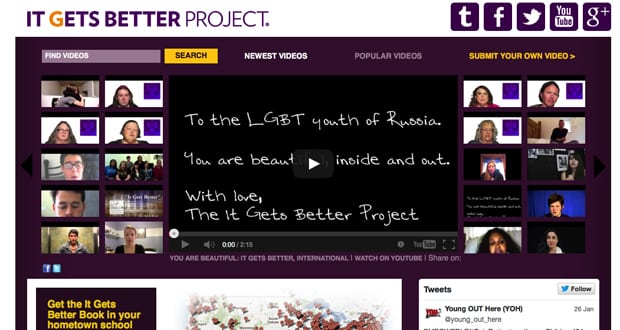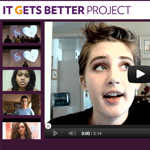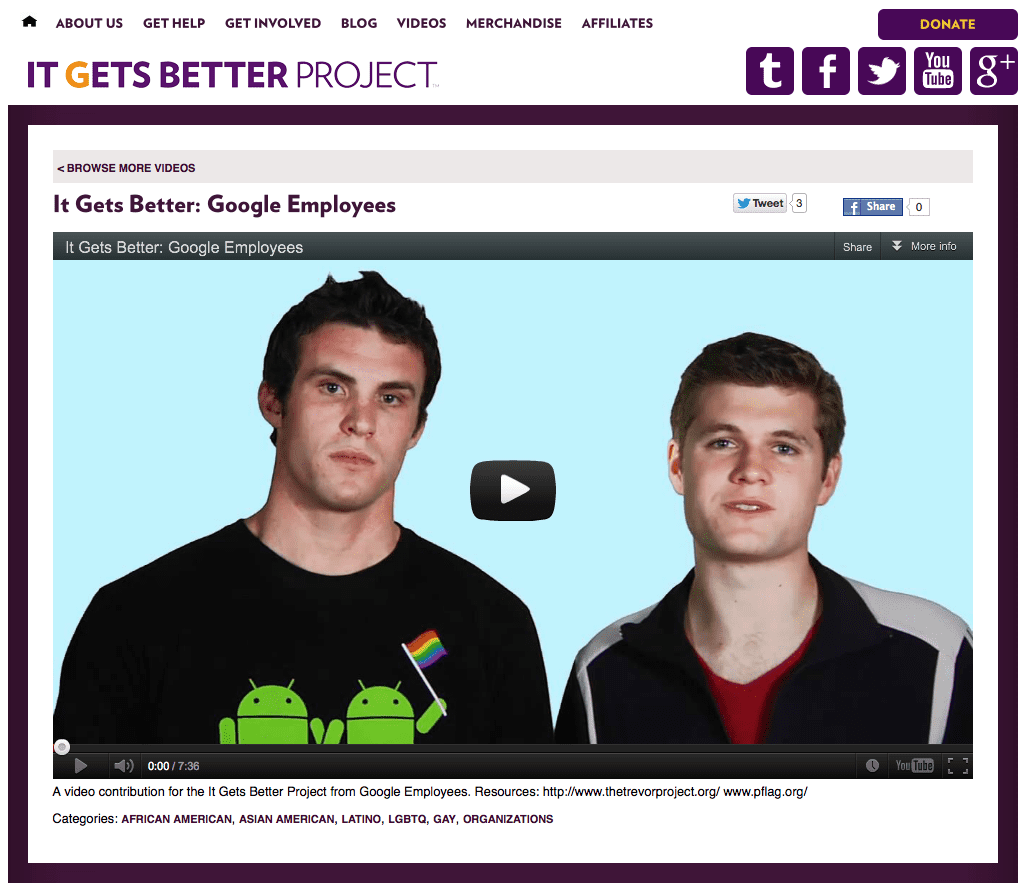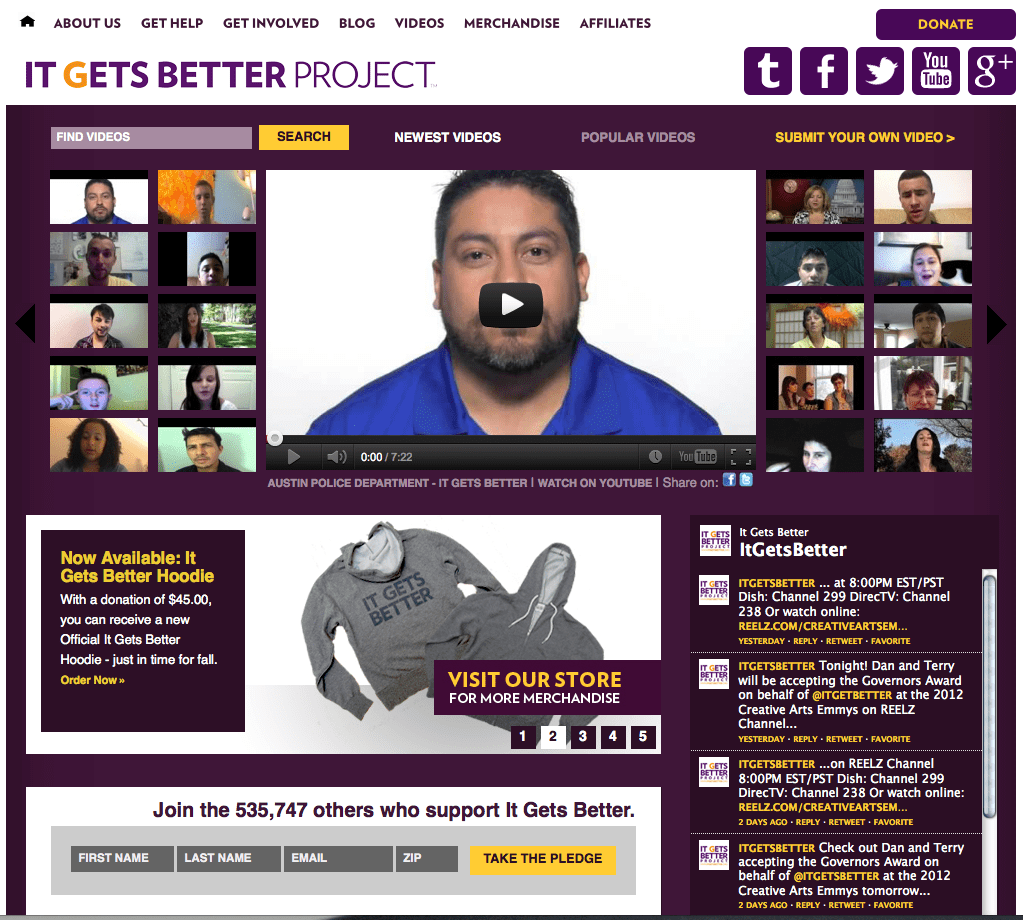Gay Adolescent Development and the It Gets Better Project

Cynthia Vinney, MA
Fielding Graduate University

ABSTRACT
Adolescence is the first time during the developmental process in which individuals are able to imagine possible futures for themselves. For adolescents who are lesbian, gay, bisexual, and transgender, this may be more difficult because of feelings of stigmatization and negative experiences like bullying. The It Gets Better Project, an online social change campaign, seeks to provide hope and visions of positive futures to gay youth through video contributions created by gay adults and other supporters. This article examines the narratives used by the campaign and its videos and how these narratives address the campaign’s primary intended audience of gay adolescents as well as a secondary audience of gay adults and other supporters. Additionally, the article analyzes how well the campaign’s narratives mesh with the narratives gay youth may feel they are living. The article concludes with suggestions for enhancements through community interaction that would make the campaign more immediately inclusive and supportive of the gay adolescents it seeks to help.
 Cynthia Vinney, MA is a user experience designer and information architect who specializes in designing intuitive and engaging user interfaces for platforms such as web, television and mobile. She is currently a consultant providing user experience strategy and design solutions for interactive projects at all phases of development for agencies including Dustland Media, Dailey & Associates and iconmobile and clients including Honda, Aspen Dental, Nokia, and Kraft. Previously, Vinney worked for top interactive and advertising agencies including RPA, Level Studios, and Schematic designing user experiences for clients such as Mandalay Bay, the California Tobacco Control Program, Acura, Time Warner Cable, VIZIO, and Logitech. Vinney holds a B.A. from Cornell University and an M.A. in Media Psychology and Social Change from Fielding Graduate University. Cynthia’s research interests include the psychology of the interactive user experience, the ways in which viewers relate to media figures, and how interactions with popular media affect the development of personal identity in adolescence.
Cynthia Vinney, MA is a user experience designer and information architect who specializes in designing intuitive and engaging user interfaces for platforms such as web, television and mobile. She is currently a consultant providing user experience strategy and design solutions for interactive projects at all phases of development for agencies including Dustland Media, Dailey & Associates and iconmobile and clients including Honda, Aspen Dental, Nokia, and Kraft. Previously, Vinney worked for top interactive and advertising agencies including RPA, Level Studios, and Schematic designing user experiences for clients such as Mandalay Bay, the California Tobacco Control Program, Acura, Time Warner Cable, VIZIO, and Logitech. Vinney holds a B.A. from Cornell University and an M.A. in Media Psychology and Social Change from Fielding Graduate University. Cynthia’s research interests include the psychology of the interactive user experience, the ways in which viewers relate to media figures, and how interactions with popular media affect the development of personal identity in adolescence.
Introduction
One of the major developmental tasks of adolescence is the formation of an individual identity. It is during this time that adolescents experience changes, including the onset of previously unknown sexual longings and desires, that cause them to notice incongruities between their past and present (McAdams, 1993). The adolescent is now able to think abstractly and can envision possible futures for their life (Crain, 2005). In working to develop their identities, adolescents actively negotiate between themselves and their social worlds. Because of this, adolescents identify with individuals who appeal to them while simultaneously rejecting others as negative figures that represent what the adolescent hopes not to become (McAdams, 1993). Further, uncertainty about their identity causes adolescents to develop in-groups through which they can define themselves. This also leads them to become intolerant and cruel to anyone they view as different (Erikson, 1958). In other words, by defining themselves as included in a particular clique, adolescents must also define who is not included. Because of the complicated process of developing identity in adolescence, teenagers have a great desire to fit in and feel accepted and “normal.” For lesbian, gay, bisexual, and transgender (LGBT) adolescents, coming out, appearing different, or concealing a hidden difference can lead to marginalization or feelings of stigmatization that can negatively impact mental health (Pachankis, 2007; Bedard & Marks, 2010). These negative feelings can be further reinforced by the dominant culture’s assumption of heterosexuality (Glover, Galliher, & Lamere, 2009) as well as the ongoing political struggles related to issues like gay marriage.
The It Gets Better Project (http://www.itgetsbetter.org/), a social change campaign originated by columnist and author Dan Savage, seeks to ease LGBT adolescents’ feelings of marginalization by sharing videos created by gay adults who can attest to the brighter future to which LGBT youth can look forward. Savage started the campaign in response to a series of suicides by teenagers who had been bullied for being gay or being perceived as gay (It Gets Better Project, 2010-2012). After its launch, the campaign quickly went viral. Thousands of gay adults along with many straight supporters have submitted video messages of encouragement, first through YouTube and later through the campaign’s dedicated website. In addition, dozens of celebrities submitted videos to the project and it has received widespread recognition.
Yet, despite this success, the It Gets Better Project’s ability to instill hope for the future in LGBT teens is unclear. By offering an alternative in-group and showing possible futures that the adolescent may not have previously imagined, the It Gets Better Project videos may have the desired effect on LGBT teens. However, there is a conflict between the hope the campaign’s videos are designed to share and the hopeless lives some LGBT adolescents may feel they are living, as evidenced by the different narratives in which the video-makers and their LGBT youth audience believe they are taking part. In the following section, the campaign’s success in reaching its intended audience will be examined by evaluating how well the campaign’s narratives mesh with the narratives gay adolescents may feel they are living. This will be followed by suggestions to enhance the campaign.
The It Gets Better Project
When Dan Savage heard about the suicide of Billy Lucas, a 15-year-old who was bullied regularly, Savage wished he could have talked to the teen and told him that his life would get better. Savage realized he was waiting for permission to talk to kids in middle and high school when no permission was needed. He could use new media to speak to bullied LGBT kids directly. Savage recorded a video with his husband, Terry, and uploaded it to YouTube in September 2010 (Stelter, 2010). A couple days later, he talked about the video in his syndicated column and encouraged other LGBT adults to record and upload videos of their own to the YouTube channel he created for the It Gets Better Project (Savage, 2010). The response was enormous and within a month, Savage was preparing a website for the campaign that would be big enough to house all the video submissions (Stelter, 2010). Today, the campaign consists of the original YouTube channel, a dedicated website, a Facebook page, a Twitter feed, a Tumblr blog, and a Google+ page. In addition, the story of the campaign’s evolution was featured in a TV ad for Google’s web browser, Chrome, a book based on the campaign’s concept was published, and MTV and Logo broadcast an hour-long It Gets Better special in February 2012, which was nominated for an Emmy for Outstanding Children’s Nonfiction, Reality or Reality-Competition program (Academy of Television Arts & Sciences, 2012b).

Two years after its launch, the campaign has maintained its cultural relevance. Another It Gets Better special aired in October 2012 (Andreeva, 2012) and, in the same month, a live It Gets Better music and theater production kicked off a national tour (It Gets Better Tour, 2012). In addition, the campaign was honored with the Governors Award at the 2012 Creative Arts Emmy Awards (Academy of Television Arts & Sciences, 2012a). Ostensibly, the campaign’s primary intended audience is LGBT adolescents who have been bullied and are feeling hopeless about their futures. However, the campaign courts gay adults and other supporters for video submissions and publicity, making this group a secondary intended audience that may be just as important as the audience of LGBT youth.
The Campaign’s Narrative
In fact, the campaign’s messaging and the narrative it creates are directed at the secondary intended audience of gay adults and other supporters. The messaging throughout the campaign’s website creates a rescue narrative in which the video-makers are heroes who rescue LGBT youth by sharing their messages of hope. This is demonstrated by the following explanation, which appears on the campaign’s website: “Growing up isn’t easy. Many young people face daily tormenting and bullying, leading them to feel like they have nowhere to turn. This is especially true for LGBT kids and teens, who often hide their sexuality for fear of bullying…While many of these teens couldn’t see a positive future for themselves, we can. The It Gets Better Project was created to show young LGBT people the levels of happiness, potential, and positivity their lives will reach – if they can just get through their teen years” (It Gets Better Project, 2010-2012). In this narrative, LGBT youth are victimized by bullies who instill feelings of hopelessness within them. The video-makers are struggling against the psychological damage inflicted by the bullies and their videos are meant to rescue LGBT kids from a pattern of destructive thought that could potentially lead to suicide. In the end, the goal of the campaign is to instill hope in the bullied LGBT adolescents that will enable them to endure long enough to get out of their current situations and discover what the video-makers have found – that it gets better (Lakoff, 2009). The campaign’s narrative is emotionally evocative and elicits empathy for bullied LGBT youth. And, as Lakoff (2009) explains, activating empathy, in turn, activates a worldview that values nurturance, responsibility, and protection. For the It Gets Better Project, this worldview, then, serves as a catalyst for the creation and contribution of videos by gay adults and other supporters.
Video Narratives
In addition to the rescue narrative, another narrative revolving around LGBT group identity is also at work, particularly in the narratives of the campaign’s videos themselves. In the videos, the contributors generally speak directly to the camera and address the bullied adolescents the campaign claims as its primary target audience. The video-makers frequently express their identification with and empathy towards bullied LGBT youth based on their similar experiences as adolescents and end with the contributors’ triumph over the isolation and stigmatization they felt growing up (e.g. It Gets Better: Andy Cohen; It Gets Better: Dan and Terry; It Gets Better: Google Employees; It Gets Better: Jennie). As a result, the videos often create what Cohler and Hammack (2007) call the narrative of struggle and success. In this narrative, the video-maker has been a victim of bullying and harassment that can lead to some very dark thoughts and moments. Yet, often after they leave their hometown for a bigger city, the video-maker eventually finds a support system. Once in this better mental and physical place, the individual indicates feeling stronger based on their victory over their earlier struggles. Thus, after finding acceptance and belonging, the contributors are able to resolve their earlier conflicts about their LGBT identity by embracing their sexual orientation as a positive. By sharing their stories through their videos, the contributors offer bullied teens a possible vision of their future that the teens may not have otherwise considered.

The Success of the Campaign’s Narratives with LGBT Adolescents
As a result, the It Gets Better Project videos provide role models to their LGBT adolescent viewers. According to Bandura’s (2001) social cognitive theory, people look to their social environments, including media, to learn how to behave. By remembering what is observed, an individual can acquire a great deal of information about how to react to various situations and then, when appropriate, can apply what they have learned by modeling their behavior on what they have observed. Importantly, media consumption greatly expands the possible models to which an individual may be exposed (Bandura, 2001) and when media viewers see people similar to themselves overcome obstacles, their belief in their own ability to do the same increases (Bandura, 2004). Thus, by offering models to which they might not otherwise be exposed, the campaign increases LGBT adolescents’ confidence in their individual agency, enabling them to believe they are capable of overcoming their negative situations.
Viewing videos that offer contact with similar others may improve LGBT adolescents’ sense of self (Pachankis, 2007). In particular, by establishing a foundation of similarity with video messages that emphasize past experiences of isolation and bullying and then continuing to detail the positive lives they now live – the part of the struggle and success narrative their audience has yet to experience – the video-makers are modeling the benefits of coping with a negative high school experience (Bandura, 2004). And, at the same time, the video-makers are instilling LGBT adolescents with belief in their own ability to cope. In addition, by showing the happy and successful lives they have developed after high school, the video-makers “create outcome expectancies that serve as positive motivators” (Bandura, 2004, p. 78) to their adolescent viewers. In combination, this enables the LGBT adolescent audience to develop the necessary feelings of efficacy and motivation that will enable them to see a path to a more positive future.
In addition, the campaign’s celebrity videos may be particularly enticing to LGBT teens that have engaged in parasocial interaction or identification with the media figures in the videos. Parasocial interaction is an interaction between a viewer and media figure in which the viewer responds as if they were engaged in a real-life social relationship (Horton & Wohl, 1956; Giles, 2002). Identification enables viewers to share a media figure’s perspective and vicariously experience life from their point of view (Cohen, 1999; Cohen, 2001). Adolescents who have previously formed these kinds of relationships with the celebrities featured in the It Gets Better Project videos may have developed a bond (Tian & Hoffner, 2010) with the celebrities that is likely to attract the adolescents to the campaign and its celebrity videos. Moreover, parasocial interaction and identification arise from a perception of similarity that leads people to “feel that similar others convey personally relevant information and [to] find interactions with them to be rewarding resulting in attraction and liking,” (Tian & Hoffner, 2010, p. 253). Consequently, LGBT youth who have experienced parasocial interaction or identification with the media figures in the videos may be particularly drawn to and more fully absorb the It Gets Better Project’s message.
Further, in adolescence the influence of the peer group becomes stronger while, at the same time, the individual spends more time alone and using media (Giles & Maltby, 2004). Because of these developments and the parasocial interactions one may engage in with media figures, adolescents may look to media for companionship (Hoffner, 2011). In fact, Cohen (1999) conducted a study of teenage soap opera viewers that found participants viewed soap characters as friends. Thus, the It Gets Better Project’s video-makers may serve a social function, offering companionship and friendship to LGBT youth who are unable to find it in their offline social environments. Consequently, for the LGBT youth who perceive their current adolescent experiences and possible futures as similar to those of the contributors they see in the videos and, therefore, are able to feel the companionship of a community they cannot find in their everyday social lives, the campaign is successful.
Evidence does, in fact, suggest that the campaign has helped LGBT youth. In the months following the start of the It Gets Better Project, calls to one of the campaign’s affiliated suicide hotlines, The Trevor Project, had increased by fifty percent (Blue State Digital, 2011). This statistic indicates the campaign has had a positive impact on its primary intended audience.
Narratives in Conflict
However, an inherent tension exists between the rescue narrative in which the campaign’s video-makers take part and the narrative some LGBT youth may feel they are living. For LGBT teens who grow up in extremely homophobic environments, it is possible homophobia has been internalized. In this case, adolescents may feel they are living an affliction narrative in which they are afflicted by their homosexuality (Lakoff, 2009). Moreover, the mental pain their affliction causes them is made physical by the bullying and isolation they experience. LGBT youth who feel they are afflicted in this manner may look to the videos from the It Gets Better Project for relief. Yet, because these videos offer no immediate solutions, instead telling kids to “wait it out,” a gap exists between the video-maker as a would-be reliever and real-life relief. For those LGBT teens that do not believe their suffering is temporary, the videos’ messages may be unable to overcome the adolescents’ pessimistic feelings about their ability to achieve a positive future (Snyder & Lopez, 2007).
In addition, because LGBT teens cannot directly interact with the video contributors, they may not get the direct positive reinforcement they really need to improve their feelings of self-worth and self-esteem. The narratives used by both the videos and the campaign itself explicitly point to the fact that LGBT youth are still waiting for their lives to improve, meaning the adolescents must make it through their current circumstances to get to the other side where the video contributors are. As a result, distance is placed between the video-makers and the LGBT teens, who are cast as powerless victims of their current situations. While the LGBT teens can aspire to be like the video-makers, the need to wait to become them may enhance adolescents’ feelings of isolation, undermining their belief in their self-efficacy as a result (e.g. Bandura, 2001). Because of this, some adolescents may not as readily experience the hope that the campaign wishes to instill in them because the challenges before them may seem insurmountable.
Potential Enhancements
While the campaign and many of its videos are designed to encourage LGBT teens to contact The Trevor Project or the National Suicide Prevention Lifeline if they need help, the It Gets Better Project offers no way for troubled LGBT adolescents to reach out directly to the campaign for relief. The campaign would more successfully reconcile the positive intent of the rescue narrative it wishes to enact and the affliction narrative some LGBT teens may feel they are living by providing more immediacy in its messaging. “It Gets Better” is future-oriented. By changing its messaging to something that communicates inclusion, acceptance, and empowerment like “you are not alone,” “community of acceptance,” or “together we’ll get through” and then backing it up with community-oriented features that enable interaction on its website, the campaign could more effectively enable bullied LGBT youth to explore the implications of their sexuality and form a connection with the LGBT community (Hoffner, 2011). Active participation in Internet groups has been shown to decrease feelings of social isolation in individuals with marginalized sexual identities more effectively than if individuals read the group interactions but do not interact themselves (McKenna & Bargh, 1998). Thus, it would benefit the campaign to incorporate features that allow users to communicate, such as discussion boards or comment systems, on its website.
Enabling LGBT teens that are inspired after viewing a video to reach out for support via discussion tools would enhance the campaign’s positive effects. Research has demonstrated that contact with supportive adult and peer role models alleviated distress stemming from one’s sexual orientation (Hetrick & Martin,1987) and that gay people who experience contact with similar others experienced an improvement in mood and self-esteem and were more fortified against negative cultural messages (Frable, Platt, & Hoey, 1998). Thus, features that enable LGBT youth to open up to older members of the LGBT community about their sexuality in a safe and accepting environment could reinforce the sense of inclusion, belonging, and acceptance initiated by the It Gets Better Project’s videos.
Conclusion
Adolescence is a difficult, stressful time for any individual, but may be that much more so for those who feel alone and stigmatized because they are lesbian, gay, bisexual, or transgender (Pachankis, 2007). While the It Gets Better Project offers a good start in providing positive role models through video messages to LGBT teens, it could be made more effective if its messages were more inclusive and its narratives more immediate. While many adolescents may benefit from hearing that “it gets better,” messages that run contrary to this frame can cause them to doubt its truth (Dominus, 2010). For this reason, if the campaign provided interactive community features that offered contact with other members of the LGBT community, the campaign could further relieve the distress and isolation experienced by LGBT adolescents (Pachankis, 2007; Hetrick & Martin, 1987; Frable, Platt, & Hoey, 1998; McKenna & Bargh, 1998). Identity development is a psychosocial process and establishing a community in which LGBT teens could have social experiences with similar others would enable them to explore their emerging sexual identities in a relatively safe space (Gackenback & von Stackelberg, 2007). Such experiences could then lead these adolescents to feel less marginalized. While the It Gets Better Project takes the first steps toward this goal, it could do more to establish and reinforce feelings of hope for the future in LGBT youth.
References
Academy of Television Arts & Sciences. (2012a, August 22). “It Gets Better” to get Governors Award. Emmys.com. Retrieved from http://www.emmys.com/articles/it-gets-better-gets-governors-award-nod
Academy of Television Arts & Sciences. (2012b). Outstanding children’s nonfiction, reality or reality-competition program 2012. Emmys.com. Retrieved from http://www.emmys.com/nominations/2012/Outstanding%20Children%27s%20Nonfiction,%20Reality%20or%20Reality-Competition%20Program
Andreeva, A. (2012, September 17). Second ‘It Gets Better’ special to air in October on MTV and Logo. Deadline Hollywood. Retrieved from http://www.deadline.com/2012/09/second-it-gets-better-special-to-air-in-october-on-mtv-logo/
Bandura, A. (2001). Social cognitive theory of mass communication. Media Psychology, 3, 265-298.
Bandura, A. (2004). Social cognitive theory for personal and social change by enabling media. In A. Singhal, M. J. Cody, E. M. Rogers, & M. Sabido (Eds.), Entertainment-education and social change: History, research, and practice (pp. 75-96). Mahwah, NJ: Lawrence Erlbaum. Retrieved from http://www.des.emory.edu/mfp/Bandura2004Media.pdf
Bedard, K. K., & Marks, A. K. (2010). Current psychological perspectives on adolescent lesbian identity development. Journal of Lesbian Studies, 14(1), 16-25. doi: 10.1080/10894160903058857
Blue State Digital. (2011, October 7). It Gets Better: One year later. Blue State Digital Blog. Retrieved from http://www.bluestatedigital.com/blog/entry/it-gets-better-one-year-later
Cohen, J. (1999). Favorite characters of teenage viewers of Israeli serials. Journal of Broadcasting & Electronic Media, 43(3), 327-345.
Cohen, J. (2001). Defining identification: A theoretical look at the identification of audiences with media characters. Mass Communication & Society, 4(3), 245-264.
Cohler, B. J., & Hammack, P. L. (2007). The psychological world of the gay teenager: Social change, narrative, and “normality”. Journal of Youth and Adolescence, 36(1), 47-59. doi: 10.1007/s10964-006-9110-1
Crain, W. (2005). Theories of development: Concepts and applications (5th ed.). Upper Saddle River, NJ: Pearson Prentice Hall.
Dominus, S. (2010, October 8). ‘It Gets Better’ starting now for gay youth. The New York Times. Retrieved from http://www.nytimes.com/2010/10/09/nyregion/09bigcity.html?ref=cyberbullying
Erikson, E. H. (1968). Identity: Youth and crisis. New York: W. W. Norton & Company.
Frable, D. E. S., Platt, L., & Hoey, S. (1998). Concealable stigmas and positive self-perceptions: Feeling better around similar others. Journal of Personality and Social Psychology, 74, 909–922. doi: 10.1037/0022-3514.74.4.909
Gackenbach, J., & von Stackelberg, H. (2007). Self online: Personality and demographic implications. In J. Gackenbach (Ed.), Psychology and the Internet: Intrapersonal, interpersonal, and transpersonal implications (2nd ed.) (pp. 55-73). Burlington, MA: Academic Press.
Giles, D. C. (2002). Parasocial interaction: A review of the literature and a model for future research. Media Psychology, 4, 279–305.
Giles, D. C., & Maltby, J. (2004). The role of media figures in adolescent development: Relations between autonomy, attachment, and interest in celebrities. Personality and Individual Differences, 36, 813-822. doi: 10.1016/S0191-8869(03)00154-5
Glover, J. A., Galliher, R. V., & Lamere, T. G. (2009). Identity development and exploration among sexual minority adolescents: Examination of a multidimensional model. Journal of Homosexuality, 56(1), 77-101. doi: 10.1080/00918360802551555
Hetrick, E. S., & Martin, A. D. (1987). Developmental issues and their resolution for gay and lesbian adolescents. Journal of Homosexuality, 14, 25–43. doi:10.1300/J082v14n01_03
Hoffner, C. (2011). Parasocial and online social relationships. In S. L. Calvert & B. J. Wilson (Eds.), The Handbook of Children, Media, and Development (pp. 309-333). Malden, MA: Wiley-Blackwell.
Horton, D., & Wohl, R. R. (1956). Mass communication and parasocial interaction: Observations on intimacy at a distance. Psychiatry, 19, 215–229.
It Gets Better: Andy Cohen [Video file]. Retrieved from http://www.itgetsbetter.org/video/entry/L4Fiq1Ltog0
It Gets Better: Dan and Terry [Video file]. Retrieved from http://www.itgetsbetter.org/video/entry/7IcVyvg2Qlo
It Gets Better: Google Employees [Video file]. Retrieved from http://www.itgetsbetter.org/video/entry/pYLs4NCgvNU
It Gets Better: Jennie [Video file]. Retrieved from http://www.itgetsbetter.org/video/entry/bj3LXVUlWqM
It Gets Better Project. (2010-2012). About Us. Retrieved from http://www.itgetsbetter.org/pages/about-it-gets-better-project/
It Gets Better Tour. (2012). Touring Schedule. Retrieved from http://www.itgetsbettertour.org/
Lakoff, G. (2009). The political mind: A cognitive scientist’s guide to your brain and its politics. New York: Penguin Books.
McAdams, D. P. (1993). The Stories We Live By: Personal Myths and the Making of the Self. New York: The Guilford Press.
McKenna, K. Y. A., & Bargh, J. A. (1998). Coming out in the age of the Internet: Identity “demarginalization” through virtual group participation. Journal of Personality and Social Psychology, 75, 681-694. doi: 10.1037/0022-3514.75.3.681
Pachankis, J. E. (2007). The psychological implications of concealing a stigma: A cognitive-affective-behavioral model. Psychological Bulletin, 133(2), 328-345. doi: 10.1037/0033-2909.133.2.328
Savage, D. (2010, September 23). Give ‘em hope. The Stranger. Retrieved from http://www.thestranger.com/seattle/SavageLove?oid=4940874
Snyder, C. R., & Lopez, S. J. (2007). Positive psychology: The scientific and practical explorations of human strengths. Thousand Oaks: SAGE Publications.
Stelter, B. (2010, October 18). Campaign offers help to gay youth. The New York Times. Retrieved from http://www.nytimes.com/2010/10/19/us/19video.html
Tian, Q. & Hoffner, C. A. (2010). Parasocial interaction with liked, neutral, and disliked characters on a popular TV series. Mass Communication and Society, 13, 250-269. doi: 10.1080/15205430903296051



